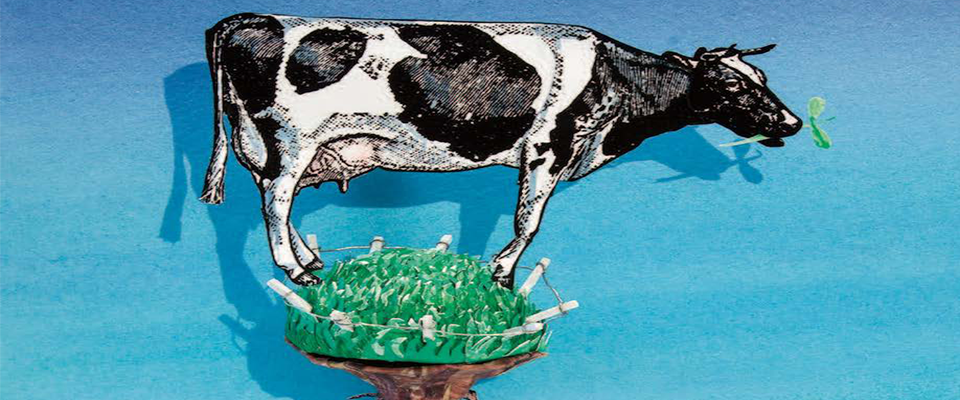In 2010, Patrick O. Brown, then a biochemist at Stanford University, and Michael Eisen, Berkeley professor of genetics, were at a board meeting in Washington, D.C., for PLOS, the Public Library of Science.
The two scientists had (with Nobel laureate Harold Varmus) founded the nonprofit nearly a decade earlier. Disturbed by the stranglehold traditional science journals had on peer-reviewed research, they set out to build something better—a new publishing platform to provide free and full access to the latest findings. Many people dismissed them as crazy idealists, but PLOS now boasts more than 160,000 peer-reviewed articles and has been a resounding success.
While waiting in line for lunch, the friends were discussing climate change when Brown, who was preparing for a sabbatical, mentioned a new project he had in mind. As Eisen recalled, “He told me he wanted to use science and the free market to change the way people eat, and the way we produce and consume meat on the planet … to figure out ways of turning plants directly into meat and dairy.”
Eisen was sold. “I share Pat’s attraction to problems that on the surface seem intractable but, if you think about them carefully and methodically, are solvable.”
If scientists could locate the molecular secret of meat’s appeal, perhaps they could re-create it in the lab, cutting cows entirely out of the equation. “The basic thinking was, if a cow can turn plants into meat, why can’t we do it?”
The environmental harm inflicted by the meat industry has been widely documented. Cows are remarkably inefficient at turning plants into food. Beef production requires 20 times more land than beans, peas, and lentils to produce the same amount of protein, and emits 20 times more greenhouse gases. Given that, it’s no surprise that agricultural and food-system reform is a top priority for environmental groups such as Berkeley-based Friends of the Earth.
“In order to avert the worst impacts of climate change and protect water supplies for future generations, we must produce and eat ‘less and better,’” FOE states on its website. “This means consuming fewer animal products, supporting the farmers and ranchers who are raising animals sustainably, and making sure that everyone has access to the healthiest options.”
Meanwhile, however, global meat consumption is increasing rapidly. And it’s not just population growth that is driving the trend. As countries like China and Brazil grow more affluent, they also consume more meat. In the case of China, per-capita meat consumption has increased more than 15-fold in the last half century. In Brazil, it increased 4-fold.
So what are we to do?
Brown, who like Eisen adheres to a vegan diet, believed that technology could provide the answer. If scientists could locate the molecular secret of meat’s appeal, perhaps they could re-create it in the lab, cutting cows entirely out of the equation. “The basic thinking was, if a cow can turn plants into meat, why can’t we do it?” said Eisen.
With that idea in mind, Brown left Stanford to launch Impossible Foods, where Eisen serves as a paid adviser. The Redwood City–based company has now engineered and brought to market a plant-based burger analog that “bleeds” like the real thing. Wheat and potato protein hold the patty together, with coconut oil giving it a nice stream of drippy fat. The Impossible Burger, currently only available in restaurants, sears on the outside while staying a nice medium-rare pink on the inside. Reviews have been mixed, but many tasters find the product convincingly and satisfyingly meaty.
How did they do it? After years of research, the company discovered that the the smell, taste, and color of meat largely derive from an iron-containing molecule called heme, which binds oxygen in our blood and muscles. Heme is always attached to a protein: hemoglobin in red blood cells, and myoglobin in muscle tissue. But it’s also found in leghemoglobin, which occurs in the roots of legumes, where it supplies oxygen to resident bacteria. In return, the bacteria convert surrounding nitrogen into nutrients for the plant.

Impossible Foods sources its heme from the roots of soybean plants. In the laboratory, the heme is grown by taking the gene that codes for the soy leghemoglobin (SLH) protein, and inserting it into the DNA of yeast called Pichia pastoris. As the yeast grows, it produces the key ingredient—and lots of it. Although the burger made from the heme doesn’t have any genetically modified ingredients, per se, it does contain the products of a genetically engineered yeast factory. That’s what alarms Friends of the Earth, which shares the climate change concerns of Impossible Foods—but is also staunchly anti-GMO.
Dana Perls ’08, a senior food and technology campaigner with FOE, began tracking Impossible Foods after the company launched its first product in mid-2016. Perls was looking specifically at issues of transparency. Last May, after she noticed that Impossible Foods had failed to mention its engineering techniques on its FAQ page, Friends of the Earth and another organization submitted a Freedom of Information Act request for the company’s communications with the U.S. Food and Drug Administration.
The resulting 63-page package includes Impossible Foods’s meeting memoranda, food safety report, and email exchanges with regulators. The most incriminating part, as Perls sees it, appears in a recap of a phone call in which an FDA official told Impossible Foods that the arguments presented in the company’s safety assessment, which it had submitted for agency review, did not establish the safety of SLH for consumption.
Under current rules, companies don’t need FDA permission to sell new food ingredients, nor do they have to notify the agency before doing so. Companies are only required to establish “reasonable certainty of no harm,” and they can do so via their own internal tests.
Impossible Foods voluntarily submitted its safety dossier, then called off the evaluation process to address the FDA’s concerns. This is not uncommon. “In instances when companies submit [general safety] notices and we do not have enough information to complete our review, companies may request we cease our evaluation of their notice,” said an FDA spokesperson in an emailed statement, adding, “This does not mean that the agency has safety concerns about the ingredient.”
“That’s the way the process is supposed to work,” said Stephen Taylor, one of the outside allergen experts Impossible Foods enlisted to review its safety tests. “This process can go back and forth several times.”
Taylor codirects the Food Allergy Research and Resource Program at the University of Nebraska–Lincoln. In his opinion, the tests that Impossible Foods performed to establish the safety of its soy protein are “the state-of-art approach.”
One way to establish the safety of an ingredient is to show evidence that it has been consumed safely by humans in the past. But there’s no record of humans munching on the roots of soybeans. So Impossible Foods hired a lab to search the literature for any reports of adverse reactions to globin proteins, and compared the amino acid sequence of SLH to known allergens. Impossible Foods says it found nothing of alarm.

The lab also tested how well the SLH was digested in a batch of gastric juices. Most known allergens are resistant to digestion in that test. SLH—along with proteins left over from the fermentation process—was digested quickly.
In response to the FDA’s questions, the company has since performed a rat-feeding trial. Rats were fed the equivalent of 200 times more heme than a typical meat eater would consume if they switched to the Impossible Foods product, and no negative impact was found.
The company has now resubmitted its safety report and is waiting for a response. The results will be made public on the FDA’s website. In the meantime, the company stands behind the safety of its product. “We would not sell the Impossible Burger if we believed there were a risk,” wrote Rachel Konrad, Impossible Foods chief communications officer, in an email.
But Perls isn’t persuaded. She feels the FDA should overhaul its “very broken regulatory system” and mandate oversight by a third party. She said the current system—in which companies can self-declare safety and sponsor their own review panels—is like a “fox guarding the henhouse,” rife with conflicts of interest. “History has taught us time and time again that we can’t trust companies to have our health and safety in their best interest.”
Perls compared the Impossible Foods environmental promises to those made by corporations claiming (erroneously, according to some sources) that use of GMOs would decrease pesticide use.
“If addressing environmental concerns is truly [Impossible Foods’s] priority, then they need to move forward with precaution … and answer the concerns of the FDA.” And precaution is a key concept to many environmentalists.
David Brower, the former executive director of the Sierra Club who founded Friends of the Earth in 1969, once proclaimed that “all technology should be assumed guilty until proven innocent.” In his ideal world, society would adhere to a “precautionary principle” by which no innovation moved forward without absolute evidence of safety.
Eisen, however, rejects the idea that we can afford to halt technology based on unknown risks, especially when the technology in question aims to address risks that are real and present. “We have humongous problems that we’re facing as a species—amongst the most obvious of these is climate change,” argues Eisen. “We can’t just gratuitously tie our hands behind our back and say we’re not going to use this technology in situations where it is perfectly safe to do so, just because some people are sort of irrationally scared of it.”
But even some who find the goals of Impossible Foods laudable wonder whether the company isn’t exaggerating its own necessity. Ann Thrupp, executive director of the Berkeley Food Institute, said the Impossible Foods mission sounds great in theory, but that she’s “a little skeptical” about the amount of money being poured into a meat-like product when there are plenty of healthy foods “that we just need to get more people to eat.” (The burger cost $80 million to develop.)
There are approximately 1.47 billion cattle roaming the Earth as of 2016. A quarter of Earth’s ice-free land is now dedicated to animal grazing, and a third of all cropland is used to grow feed.
Thrupp suggested that our demand for meat could be addressed with public health campaigns, and that inhumane farming systems could be reformed with the help of government incentives. “People think that things aren’t possible, like changing our meat consumption; but the increasing recognition of the health impacts [of meat] has already switched lots of people.” And for those who still demand meat, Thrupp said, “at least portion [sizes] can change, and values can change, over time.”
Perls agrees. She believes people want “real food,” and considers approaches like those adopted by Impossible Foods overly simplistic. The real solution, Perls insists, lies with farmers invested in sustainable, organic agriculture. “We are not going to solve the very problematic issues related to factory farming with a silver bullet,” she said. “And the choice between factory farming and risky genetic engineering is like snake oil.”
Eisen scoffs at this idea. The question, he said, arms raised in exasperation, is not about traditional farming versus factory farming. The problem is that there are simply too many cows on the planet.
There are, in fact, approximately 1.47 billion cattle roaming the Earth as of 2016—up over a half billion from 55 years ago, according to the Food and Agriculture Organization of the United Nations (FAO). The organization also reports, as of 2018, that a quarter of Earth’s ice-free land is now dedicated to animal grazing, and a third of all cropland is used to grow feed.
“If global meat demand continues to rise at its current rate, it will literally require the entire planet to be a pasture for cattle,” Eisen said. “There’s just no way, you know—we’d have to colonize new planets in order to have enough cows to meet everybody’s desire for meat.
“Everyone is going to face this challenge as a species, inevitably, and so what we are offering the world is a way to continue to love and eat meat, and still occupy planet Earth.”
Ricardo San Martin, a visiting professor who teaches a class on alternative meat at Berkeley’s Sutardja Center, is optimistic about the field’s potential. But he thinks the challenges run deeper than mere taste; cooking is deeply personal, and food is about culture and memories, not just proteins and sinewy textures.
“Eating means so many other things. It’s not just a bunch of engineers saying ‘We can mimic the thing, the molecules are the same, you’re gonna eat it.’ You may not eat it.”
But for Eisen, those psychological and cultural challenges go hand-in-hand with the engineering ones. People generally have an “almost magical belief” that meat has to come from an animal, he said. But if Impossible Foods can achieve its goals to exactly mimic all kinds of animal products (the company is now looking at chicken, pork, and even dairy), then ideas about what they are can change, while traditions stay intact.
It may take time to convert people, but he stressed that the company is still in its infancy and will only get better. “This is version one,” Eisen said. “We’ve been at this for five or six years—the cows have been at this for millennia.”
Former California intern Virgie Hoban ’16 was news editor at The Daily Californian and a science reporter for the Boston Globe.






















